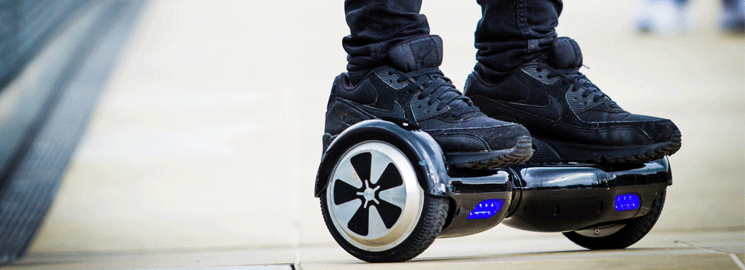One of the top toys found under the tree this year may just be too hot to handle. It appears that hoverboards, also known as self-balancing scooters, may be this year’s trendy transportation device but safety concerns about this technology — in particular that some of the batteries and charging equipment have caused fires — are making the toy a potential hazard to travel with and even use this holiday season. So for anyone who doesn’t know what a hoverboard is, even though it says hover in the name this board does not actually float above the ground. It looks like a Segway electric scooter minus the handle that helped you balance yourself.
So essentially, its a board with wheels however you control and steer it with subtle movements of your feet, legs and torso all the while getting power and movement from a lithium ion battery. Now the battery in some of these devices seems to be at the heart of the hazard of this controversy . Hoverboards are powered by a lithium ion batteries and after looking into this matter further, buying a cheap knock-off might put you at potential risk of the battery overheating or even catching on fire.
Some retailers are pulling the product from their virtual shelves because of safety concerns, Online retail giant Amazon (who seems to be selling a good portion of these boards) appears to be taking some precautionary moves as well. It looks like they sent a notice Friday to all hoverboard makers demanding they prove their products comply with certain safety standards, including battery and charger types.
The problems with some boards seem to stem from the type of lithium-ion battery they contain. Some of the lower-quality or counterfeit boards and batteries have been linked to fires as a direct result of them being poorly made because they are knock-off models and therefore cheaper to buy. One Canadian distributor of a hoverboard that I was in contact with says the devices became popular so quickly that poorly made knockoffs almost instantly flooded the market making it difficult to determine which ones were of good quality and which ones were not.
Air Canada banned them as of Dec. 8. WestJet also has a ban. As a precautionary measure effective December 8, 2015 as well, Air Canada no longer accepted small, lithium-battery powered vehicles as checked or carry-on baggage given safety risks associated with the size of the batteries that power them. These items are commonly referred to as hoverboards, electric skateboards, airwheels, mini-Segways and balance wheels. So something to consider if you are planning on travelling with one or are planning on buying one and bringing it back with you on a flight.
With that in mind, it also seems like many provinces across Canada are not allowing hoverboards on public roads sidewalks, trails, parks and bike paths with fines being implemented for people breaking this law. So, not only are they a potential fire hazard, but they are also a public liability.
There are many different companies and outlets selling hoverboards, starting around $400 and reaching up to $1,800. Many of them work just the same, with minor differences in specs and style. The biggest factor to consider when shopping is price because most hoverboards have similar specs. Nearly all can carry the same weight and have similar maximum speeds.
So some of the more popular brands that seem to be more reliable out there include Swagway, IO Hawk, and Monorover. They can be purchased from Amazon, Kijji, and BestBuy, however, if you are concerned about purchasing knock-offs, I’d order directly from the manufacturer instead then you will can almost certainly avoid getting a counterfeit one.
ABC News – Hoverboards Catching Fire

